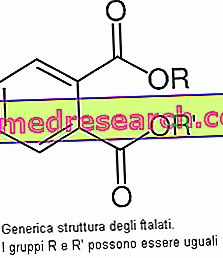What are phthalates?
Phthalates are esters of phthalic acid, obtained by esterification of phthalic anhydride and an alcohol. The most common phthalates are diisodecyl phthalate (DIDP), diisononyl phthalate (DINP), benzylbutyl phthalate (BBzP), and especially di-2-ethylhexyl phthalate (or dioctyl phthalate, DEHP).

Applications of phthalates
Phthalates are widely used in the plastics industry and their role is fundamentally that of "plasticizing agents", since their integration with the polymer improves both the flexibility and the modeling of the finished product.
PVC is the main plastic material (in terms of production volume) in which phthalates are added; in particular, benzybutyl phthalate (present in expanded PVC) and di-2-ethylhexyl phthalate (an ester between phthalic acid and 2-ethylhexanol used mainly in the constitution of normal PVC) represent the vast majority of the use of phthalates in the plasticizing industry .
By adding the phthalates to the PVC, a lubricating effect is obtained between the molecules of the polymer itself, which manage to slide over each other, increasing both the softness and the malleability of the product even at low temperatures.
Phthalates obtained by esterification to light alcohols are instead used as solvents in perfumes or pesticides, while other phthalates find frequent use in the preparation of nail polishes, adhesives, paints and foods.
Toxicity of phthalates
Let us begin by pointing out that phthalates food contamination is absolutely unavoidable but, despite the alarmists, it has not yet been demonstrated in humans that they cause sterility or worse cancer. These are extremely easy to disperse molecules, so that traces of phthalates have been identified in the Himalayas or in the islands of the Pacific Ocean, places that are probably reached by rainwater condensed in clouds and contaminated elsewhere.
Phthalates, as well as bisphenol, represent a group of molecules whose industrial application has been extremely challenged by hygienic control bodies; in fact, since the 1970s (a decade in which the results of many surveys have been disclosed) the use of phthalates has been associated with numerous side effects and related complications.
The first side effect attributed to phthalates was the potential of "feminization" towards male babies; it seems that in guinea pigs the phthalates almost perfectly imitate the estrogenic action at the SYSTEMIC level resulting in a more or less significant (probably dose-dependent) disorder in genital development and testicular maturation.
Not only that, these studies have documented many other undesirable effects attributable to the administration of phthalates; among these we remember:
- Liver damage
- Damage to the kidneys
- Lung damage
As one could easily guess, such results should determine the abolition of the use of phthalates, if it were not that other analogous experiments conducted on primates did NOT show any complication on the testicles of the male subjects nor did they confirm the potential of carcinogens . Obviously, the outcome of these studies once again questioned the probable (or unlikely) toxicity of phthalates for humans.
Phthalates are poorly soluble but above all biodegradable molecules; their decomposition is rather rapid and although they represent an almost ubiquitous pollutant component, not even the in-depth studies on the fauna of the areas most at risk have provided useful elements to justify the industrial abolition of the use of phthalates.
The latest studies come from Denmark, where a team of specialists confirmed the unfairness of phthalates at doses of 500mg / day (half a gram); if we consider that on average in a lifetime the human being introduces a dose <10g (less than a spoon), it is possible to include that this is a group of almost harmless molecules.
Bibliography :
- Tomonari et al, The Toxicologist, 2003



